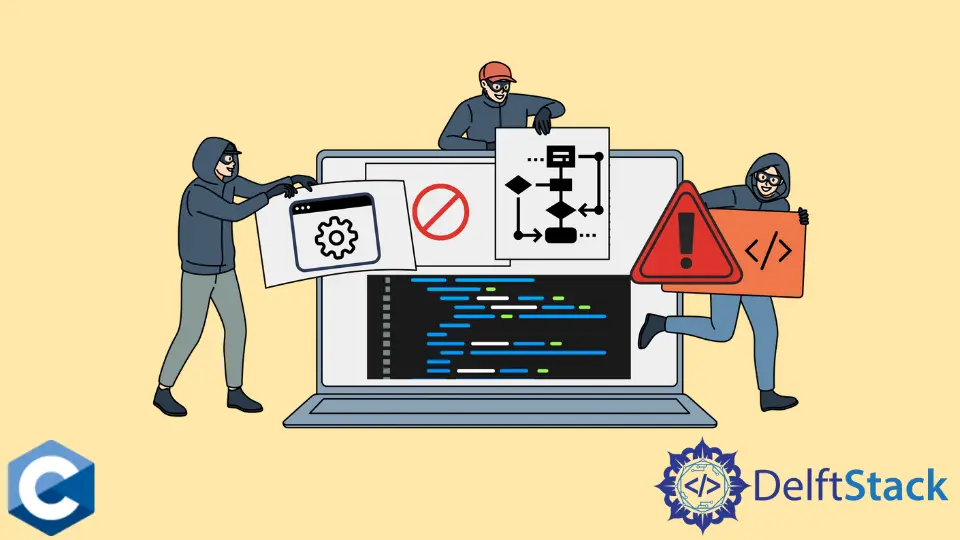在 C 语言中杀死一个子进程

本文将演示有关如何在 C 语言中杀死子进程的多种方法。
使用 SIGKILL 信号终止 C 语言中的子进程
有多种信号设计用于在进程交付时终止该进程,但是发送 SIGKILL 信号是执行此任务的最强大,最可靠的方法。通常,程序可以注册称为信号处理程序的特殊功能,一旦将相应的信号传递到程序,这些特殊功能便会自动调用。用户实现处理程序功能代码,该代码通常会对程序进行一些清理工作。除函数处理程序外,对传递的信号可能有默认操作,例如阻塞和忽略。虽然,给定功能不能忽略,阻止或处理 SIGKILL 信号。因此,在尝试终止进程时,此方法应该是最后的选择。
可以通过 kill 系统调用来发送 SIGKILL 信号。但是请注意,在以下代码示例中注册的 SIGTERM 处理程序无法捕获提供的 SIGKILL,它会立即终止给定的子进程。
以下程序产生一个子进程,并在其中注册 SIGTERM 处理程序。然后,除非传递信号,否则子进程将执行无限循环,这将翻转 while 表达式变量。因此,父级传递的 SIGKILL 信号不会调用处理程序并立即终止子级进程。
#include <signal.h>
#include <stdio.h>
#include <stdlib.h>
#include <string.h>
#include <sys/wait.h>
#include <unistd.h>
volatile sig_atomic_t shutdown_flag = 1;
void cleanupRoutine(int signal_number) { shutdown_flag = 0; }
int main(void) {
int wstatus;
pid_t c_pid = fork();
if (c_pid == -1) {
perror("fork");
exit(EXIT_FAILURE);
}
if (c_pid == 0) {
printf("printed from child process - %d\n", getpid());
int count = 0;
struct sigaction sigterm_action;
memset(&sigterm_action, 0, sizeof(sigterm_action));
sigterm_action.sa_handler = &cleanupRoutine;
sigterm_action.sa_flags = 0;
// Mask other signals from interrupting SIGTERM handler
if (sigfillset(&sigterm_action.sa_mask) != 0) {
perror("sigfillset");
exit(EXIT_FAILURE);
}
// Register SIGTERM handler
if (sigaction(SIGTERM, &sigterm_action, NULL) != 0) {
perror("sigaction SIGTERM");
exit(EXIT_FAILURE);
}
while (shutdown_flag) {
count += 1;
}
printf("count = %d\n", count);
exit(EXIT_SUCCESS);
} else {
printf("printed from parent process - %d\n", getpid());
int ret;
sleep(5);
ret = kill(c_pid, SIGKILL);
if (ret == -1) {
perror("kill");
exit(EXIT_FAILURE);
}
if (waitpid(c_pid, &wstatus, WUNTRACED | WCONTINUED) == -1) {
perror("waitpid");
exit(EXIT_FAILURE);
}
}
exit(EXIT_SUCCESS);
}
使用 SIGTERM 信号终止 C 语言中的子进程
或者,可以使用 SIGTERM 信号终止子进程,该信号可以由程序处理。下一个代码示例重复了以前的程序实现,只不过它用 SIGTERM 代替了 SIGKILL 信号。sigfillset 函数用于防止其他信号中断已注册的处理函数执行。处理程序代码修改全局 sig_atomic_t 类型的变量,该变量在子进程中停止 while 循环并打印 count 变量的值。请注意,在注册处理程序时,最好使用 signal 函数调用上面的 sigaction,因为 POSIX 标准没有详细规定后者。
#include <signal.h>
#include <stdio.h>
#include <stdlib.h>
#include <string.h>
#include <sys/wait.h>
#include <unistd.h>
volatile sig_atomic_t shutdown_flag = 1;
void cleanupRoutine(int signal_number) { shutdown_flag = 0; }
int main(void) {
int wstatus;
pid_t c_pid = fork();
if (c_pid == -1) {
perror("fork");
exit(EXIT_FAILURE);
}
if (c_pid == 0) {
printf("printed from child process - %d\n", getpid());
int count = 0;
struct sigaction sigterm_action;
memset(&sigterm_action, 0, sizeof(sigterm_action));
sigterm_action.sa_handler = &cleanupRoutine;
sigterm_action.sa_flags = 0;
// Mask other signals from interrupting SIGTERM handler
if (sigfillset(&sigterm_action.sa_mask) != 0) {
perror("sigfillset");
exit(EXIT_FAILURE);
}
// Register SIGTERM handler
if (sigaction(SIGTERM, &sigterm_action, NULL) != 0) {
perror("sigaction SIGTERM");
exit(EXIT_FAILURE);
}
while (shutdown_flag) {
count += 1;
}
printf("count = %d\n", count);
exit(EXIT_SUCCESS);
} else {
printf("printed from parent process - %d\n", getpid());
int ret;
sleep(5);
ret = kill(c_pid, SIGTERM);
if (ret == -1) {
perror("kill");
exit(EXIT_FAILURE);
}
if (waitpid(c_pid, &wstatus, WUNTRACED | WCONTINUED) == -1) {
perror("waitpid");
exit(EXIT_FAILURE);
}
}
exit(EXIT_SUCCESS);
}
Founder of DelftStack.com. Jinku has worked in the robotics and automotive industries for over 8 years. He sharpened his coding skills when he needed to do the automatic testing, data collection from remote servers and report creation from the endurance test. He is from an electrical/electronics engineering background but has expanded his interest to embedded electronics, embedded programming and front-/back-end programming.
LinkedIn